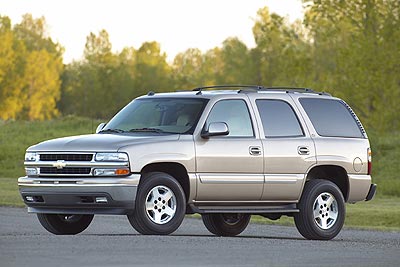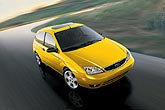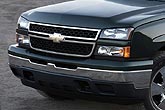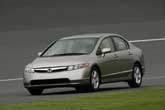Recent Articles
Popular Makes
Body Types
Making Sense of Incentives
Slow sellers, big hits and why automakers discount their cars

Somewhere between the glamour of new cars posed on the cover of glossy magazines and the classified section headlines that scream about untouchable deals – you know, five at this price -- you will discover the truth about buying a new car. So let’s get down to it. The truth is that any salesperson worth their shoes will try to get as much as they can out of every sale. That’s how they feed Junior. But you need to feed your own child, and that can be hard to do when you’ve got a big fat car payment dangling off your neck like a rap star’s Apollo medallion. So you do your homework, you read lots of information – but still, it’s all a hazy maze. Customer Cash? Marketing Support? What? Today’s auto market is among the best in many years, but it is also much more complicated. Never have there been as many choices as there are today, and incentives play a very large role. In the past, rebates were used during specific times as a way to reduce inventories of outgoing vehicles. It was, in essence, the automaker’s version of a department store weekend sale. Thanks to what some in the business called “discount marketing,” that changed and rebates became a central part of the automotive sales world – mainly to get us consumers to buy a car a little earlier than normal. By raising suggested retail prices and then applying a layer of “automatic” rebates – so that people thought they were getting a deal – some automakers altered the auto buying landscape much like a wildfire forever changes a canyon. With rebates used in this expanded fashion, they could control sales virtually month-to-month or quarter-to-quarter simply by cranking up discounts until people couldn’t resist what looked like a fire sale. Like a spastic yo-yo, sales responded – first, records were broken and then a precipitous drop occurred. But then vehicles at Chrysler, Ford, and GM lots stopped selling altogether, and not even employee pricing could put the sales back together again -- or even pleas to “Buy American.” Sticker prices were still too high, those in the market were already driving new rigs, and new models failed to sway additional buyers. Soon new cars were joined by newer models and, then, still newer cars. Lot kids were challenged to figure out how the heck am I gonna all these Tahoes on the lot at the same time? The answer – still -- is to slap a big fat rebate on the sticker price, but this time it's back to where it all started – rebates to clear inventory. Only problem is that there’s a big inventory, so big rebates are needed, though the likes of Chrysler, Ford and GM are slowly getting themselves out of the mess all these plans caused in the first place. Until the existing overstock of models is gone, however, you can count on increasingly aggressive rebates and finance plans on 2006 and 2007 models. The basic rule is this: the more desperate an automaker/dealer is to sell a car, the better deal you’re gonna get, through the use of rebates and smart negotiating. It’s an opportunity to buy a new car for less – an opportunity that’s wasted if you buy for the deal and not for the car. True winners will get both.
Types of Incentives
Automakers and dealers use a number of methods to induce sales on slow-selling or just released models. Generally, you can’t combine finance and rebate offer from the automaker into one super deal, though it has happened recently. Essentially, that’s what DaimlerChrysler’s recent Employee Pricing promotion was all about: two discounts. And, for a short time earlier this year, Ford was offering cash back and lower finance rates. So if you can find ‘em, they’re worth a good look. What you can do, however, is combine an automaker offer with dealer cash back. While it can take some difficult negotiating to extract dealer cash when the automaker also offers a spiff, it can be done depending on how motivated the dealer is to sell a car to you. For example, if you’re shopping for a Camry, well, there will be another Camry shopper on the lot in a pretty quick jiffy (Camrys last about ten days on dealer lots), so your leverage is compromised. With today’s gas prices, if you’re looking to buy a Chevrolet Tahoe – you just might be able to make a deal. Finance offers: You’ve seen the headlines: Yeah – right. And if you were late on a credit card payment back in 1997... It’s true that very low finance rates are usually reserved for customers in the top two credit tiers. But that’s changing: Ford’s 2006 Labor Day Sales Event offered virtually all customers -- including those with sub prime credit scores -- zero percent for a staggering 72 months. Low or zero percent finance offers are certainly tempting, especially if you can score a great rate with bad or mediocre credit. Obviously, it’s a great way to keep your monthly payment down. If you’re financing, those with good credit would be wise to get an offer from outside the dealership, then, if you wish to see what the dealer offers, you can sit back and compare. Whenever you can combine a discount with low financing, that's worth a serious look. Cash Back/Rebates: There are two basic types of automaker rebates: national, and regional. National rebates include all dealerships, while regional offers focus on slow selling cars in certain areas of the country. Whether national or regional, like most all things on sale, cars generally get rebates because they aren’t selling -- or there’s a better model coming out. In addition, many automakers will also offer smaller discounts for special groups like the military, first time buyers or recent college grads. Lately, though, big rebates have been getting crazy: With sizeable dollar figures, it may seem like you’re getting a great deal, but remember that it’s all related to the actual price of the vehicle. Since 2001, vehicle inventories – the number of models a typical dealership has for sale – have grown for certain types of vehicles, and, as a result, rebates have ballooned. For 2006, the Labor Day sales weekend boasts several vehicles with rebates of 20 percent or more off the base model sticker price – most of which are on either slow-selling trucks or large suvs. Some are also outgoing models, like the 2006 Chevrolet Silverado, which is offering a 24 percent discount off the base model sticker price. This won’t last, however: domestic automakers are beginning to lower sticker prices instead of padding on rebates, giving buyers a more realistic idea of the actual price of a vehicle. The possible exceptions are large SUVs and trucks, for as fuel prices rise, these vehicles suffer the most -- and continued rebates may be the only way to relieve model overload, making 2006 a great year to buy a truck or an SUV – as long as you own shares in Exxon. What’s important to keep in mind if you’re intrigued by a big rebate is that it’s not such a great deal if the car should have been selling for less to begin with, so check its direct competitors and get an idea of the real value on the vehicle you wish to buy. It’s also important for shoppers to take note of the expiration: it’s based on the delivery date. Dealer Incentives: A common refrain heard across dealerships is the old song and dance. And shocker of shockers, it’s not really true. Dealers have all sorts of hidden pockets of cash from automakers they use to either pad their profit or make a deal. Like automaker rebates, dealer incentives are used to sell lot dogs or outgoing models; dealers also can get bonuses after achieving sales targets or for purchasing certain cars from the automaker. There’s marketing support cash, which dealers use at their discretion -- in other words, like never. Dealer Holdback: Okay, tough guy. If you think you can chip away at a dealer’s holdback cash...ah, guess again. Unless you’re offering to buy a purple and gold PT Cruiser with shag carpeting and a missing steering wheel, you won’t get a whiff of that little profit pocket. Holdback is a set margin, at most 3 percent, based on the invoice or the base sticker price of a car and included in the invoice price. That means that the invoice price you see really what dealers pay – at least not ultimately. While they pay the invoice plus holdback up front, they get the holdback later in the year from the automaker. Here’s how it works: You’re a Honda dealer, and you buy a Civic from Honda that has a base MSRP of $15,000. Included in the invoice price you pay is a $450 holdback margin (3 percent of MSRP), which you get back throughout the year. So, a salesperson who says that they won’t make any money selling a car at invoice is either unaware of the holdback or, ahem, holding it back. Though it’s really not a negotiable margin, it’s valuable to know about holdback so you know how much money a dealership is making on the sale of a car, and the fact that you can actually buy a vehicle at invoice. Special Lease Deals: Want a low monthly payment, a low (maybe zero) down payment and don’t care how much you owe when the term is over? We didn’t think so. For those who do find leases convenient, however – luxury car buyers in and out of a car in a few years with no intent to own the vehicle long term and content to roll into, say, another Lexus, special leases are a viable option. Indeed, it’s increasingly becoming a luxury-only deal, as mainstream vehicles offer larger rebates and low finance rates that compete with the benefits normally derived from a lease. Buyers should be wary of the residual value at the end of the lease term, however, as well as the amount of miles allowed and vehicle condition stipulations. There are also lease swapping programs and auctions available, which makes it easier to get out of a leased vehicle you no longer want -- or into one at a lower payment for less time. Special Incentives: that’s right: you can get a nice tax credit when you buy a qualifying hybrid vehicle – among the more notable special incentives available today. My, my. How times have changed. Why, it seems like only yesterday big SUVs and trucks were given incentives by the government for “small business” use. That’s all gone, replaced by hybrid mania, so look for more special incentives for clean-burning and fuel efficient cars. There are also special-use incentives, so check your state regulations or your dealership if you plan to use your vehicle for more than daily transportation.

Which Cars Get Incentives
Losers get incentives. As harsh as that sounds, it’s true: rebates go to cars that can’t sell or cars that get pushed out in favor of updated models. But even losers deserve to be loved -- just be sure you know why that vehicle you’re thinking about buying is on sale. If you buy an outgoing model, be prepared for the shock you’ll get when you find out that the new version is much better than the one you have parked in your driveway. If you’re good with that – then have at it. For example, you may be able to get some cash off the price of a 2006 Honda CR-V. That’s great, except that a more powerful and refined model is due to hit dealerships at any time. And remember: buying a car isn’t really about getting the car on the cover of the automotive magazine. It gets more complicated for slow-sellers, but here are four main reasons why a vehicle fails to sell:

Which Cars Never Get Incentives
Winners avoid the sales rack. It’s as obvious as it is true: popular cars never get rebates, and if they do, it’s usually a small introductory amount – or a slight discount to get outgoing model year vehicles off lots. Consider, for example the 2006 Honda Civic. If you’re waiting for some decent cash back on a Civic, get comfortable. Honda’s bread and butter car is flying off lots. Others are also faring well, such as the new Dodge Caliber. Those cars with the right mix of sales and production also stay away from cash back. It’s simple: demand means no rebate rejoicing, something import automakers do really well: keep production down in order to jack up transaction prices and keep demand high. And oh, yeah: as President George Bush says, they "build relevant models." Right now, if a vehicle gets class-leading gas mileage, it’s selling, or if it’s an exciting new model that captures the attention of the buying public. Take Scion: when these trendy little cars first debuted, gas mileage wasn’t such a big issue but its core group of buyers responded overwhelmingly to the models and Toyota kept production low by utilizing an ordering purchase program. For example, you didn’t usually show up at a Scion lot and drive off in a car; you ordered your Scion and took delivery when it arrived. Honda, also, uses its rebate dollars to move outdated models and any overstock from dealer lots – though that’s changing slightly. Honda recently decided to allocate more rebate dollars to North America, in response to sluggish sales of less fuel-efficient models like the Honda Pilot and Ridgeline. Here’s a list of mainstream cars that will rarely ever get a big rebate.
Photos courtesy of the Automakers, Ron Perry
